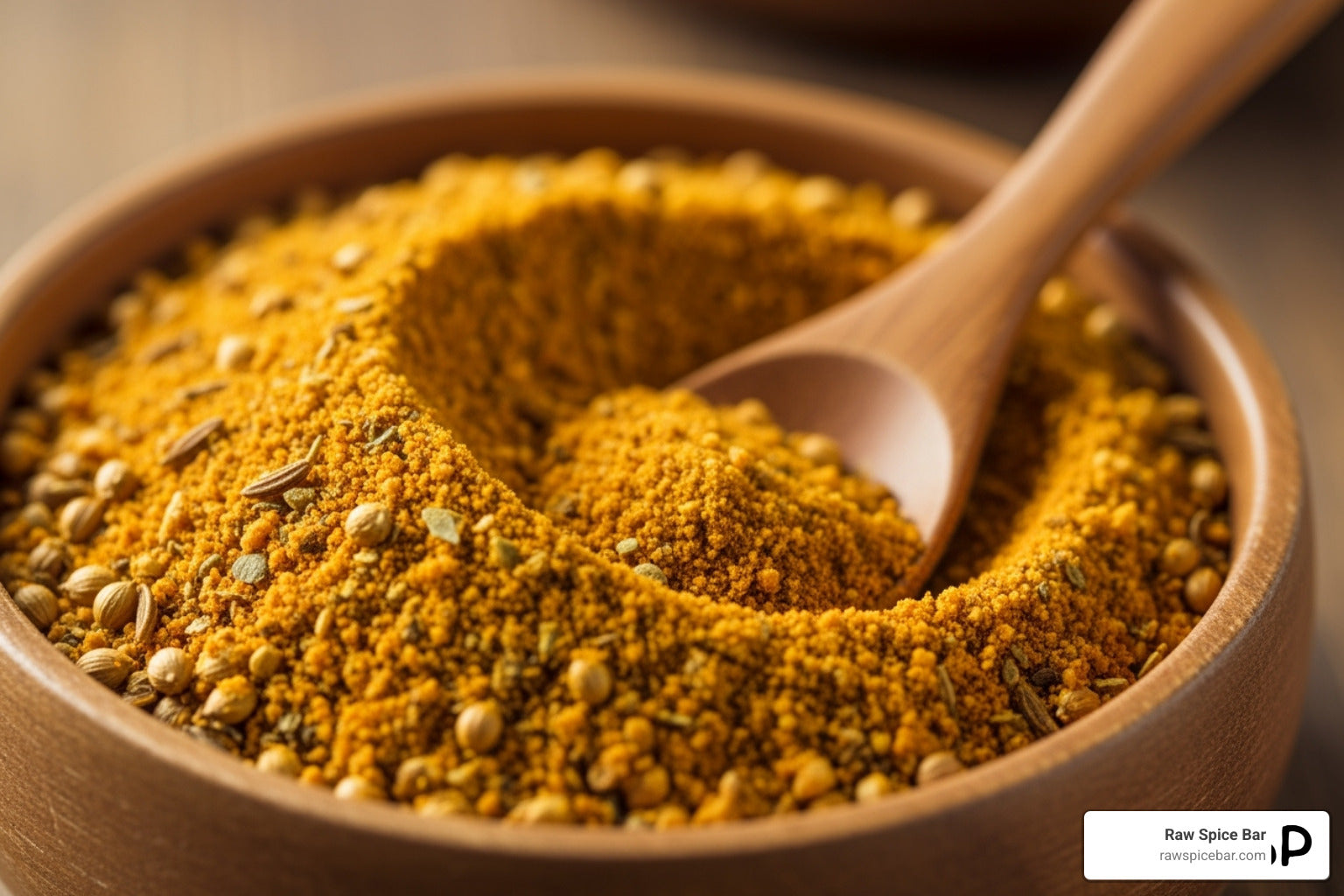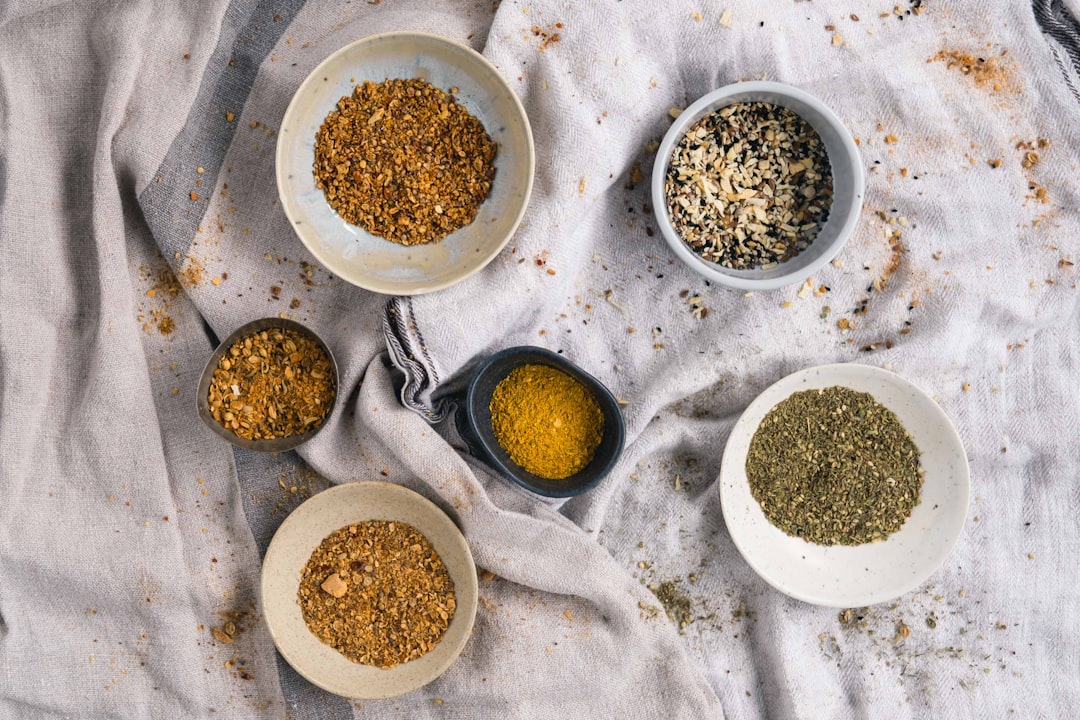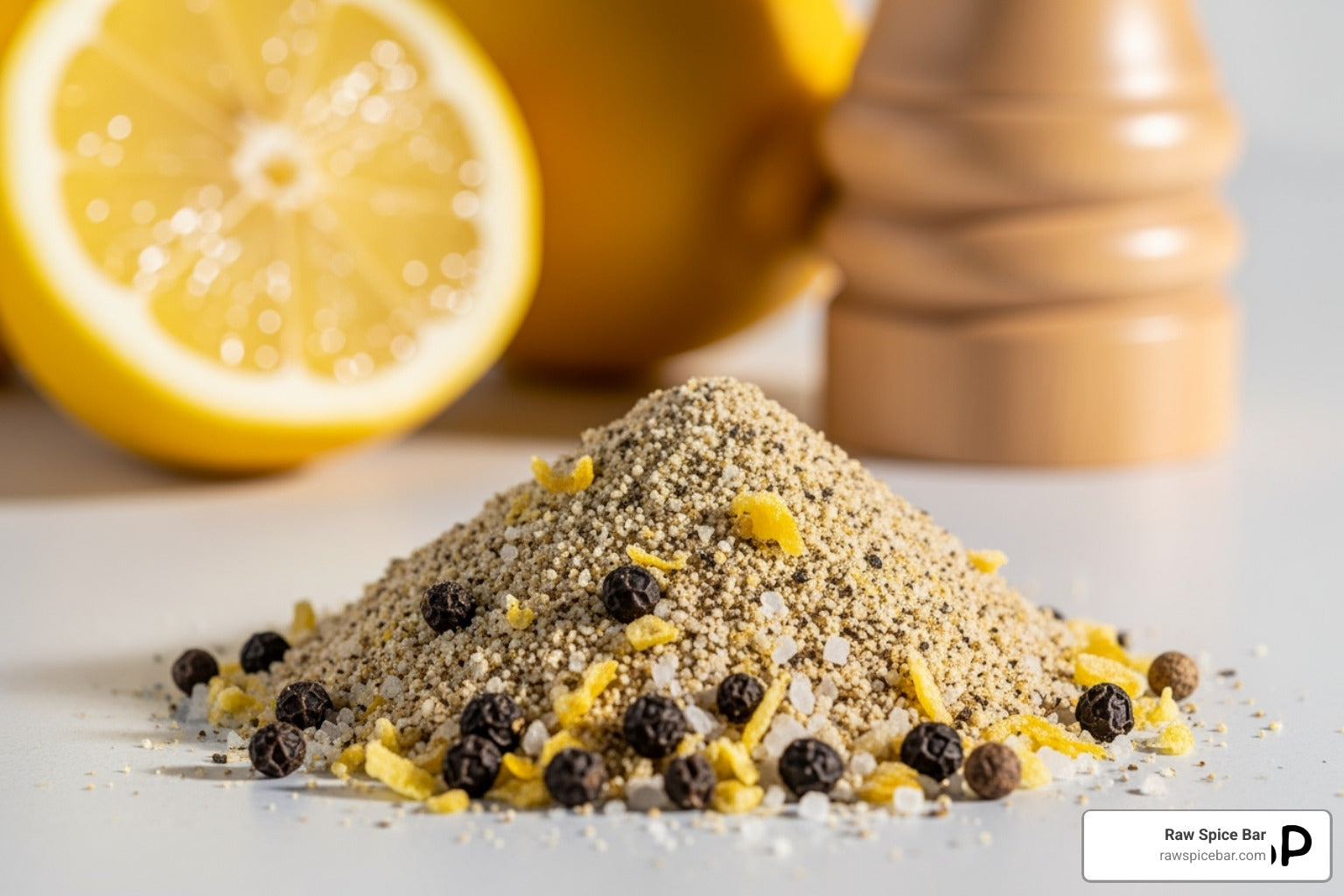Imagine transforming your cooking from average to mouth-watering with the right seasoning blend.
Picture the dishes you love with a burst of authentic, global flavors that make each bite memorable.
To achieve this, the key is to have perfectly balanced seasoning blends that are ready to bring any cuisine to life. Whether it’s a pinch of Herbes de Provence for French delicacies or the vibrant warmth of tikka masala spices for Indian dishes, the right blend is crucial.
At Raw Spice Bar, we offer spice blends that capture the essence of global cuisines and bring them directly to your kitchen. Our subscription service sends you fresh, handcrafted spice blends to elevate your meals. Imagine cooking with spices so fresh, they transform your favorite dishes with every sprinkle.
Explore the world of flavors with our spice subscription. It's designed to make seasonal cooking easy and exciting, ensuring you always have a new flavorful adventure waiting at your doorstep. With our blends, your meals will become an exploration of taste, transporting you to different parts of the world with each dish.
In this blog, you will discover:
-
How perfectly balanced seasoning blends can elevate your meals and bring out the best in your dishes.
-
The cultural significance of seasoning blends, adding authentic flavors to your cooking.
-
How RawSpiceBar's subscription service makes seasonal cooking exciting and easy with fresh, handcrafted spice blends delivered to your door.
Let’s get started!
The Art of Blend
Crafting the perfect seasoning blend is an incredible journey through flavors and cultures. It's about combining specific spices to elevate your dishes and transform your cooking experience.
Understanding Flavor Profiles
Creating a seasoning blend requires a deep understanding of flavor profiles.
Each spice and herb contributes unique taste characteristics to the blend. You'll often need to balance sweet, salty, bitter, and spicy flavors to achieve harmony. Some spices, like clove, can be strong and overpowering. They are best used sparingly.
Experiment by starting with a few key spices. Cinnamon brings warmth and sweetness, while cumin adds earthy notes. You can build complexity by introducing herbs like thyme or rosemary.
When you understand these flavor profiles, you’ll be better equipped to create blends that enhance your meals. This understanding allows you to tailor your blends for different types of dishes, making each meal special.
Cultural Significance of Seasoning
Seasoning blends hold a great cultural significance. They often encapsulate the essence of regional cuisines.
For instance, a Creole blend recalls the vibrant music and festivities of New Orleans. Meanwhile, a Greek blend can transport you to the Mediterranean.
Our spice subscription service delivers new and authentic blends to your door every month. It is a chance to explore diverse culinary traditions from around the globe. This subscription makes it easy for you to cook with the freshest spices, adding authenticity and flavor to your dishes without leaving your kitchen.
Key Ingredients in World Cuisines
Certain ingredients form the backbone of many global cuisines, contributing distinct flavors and aromas to dishes. Understanding these key components allows you to enhance your cooking with international flair.
Herbs and Spices Fundamentals
Herbs and spices are essential in creating authentic flavors.
-
For instance, cumin is often found in Mexican and Indian dishes for its earthy taste.
-
Basil and oregano are crucial in Italian cooking, imparting fresh, aromatic qualities.
-
Turmeric is widely used in Asian dishes, offering a warm, peppery flavor and vibrant color.
Each spice adds unique notes, helping you craft meals that resonate with specific regional identities.
Regional Staple Ingredients
Some ingredients are staples in specific regions and form the heart of local dishes.
In Asian cuisine, rice and soy sauce are fundamental. Olive oil and tomatoes are frequent stars in Italy, while the Middle East relies on chickpeas and yogurt.
These ingredients are integral to the culinary traditions of their regions and enhance the nutritional value of meals, offering a rich tapestry of flavors and textures to explore.
Table of Regional Staples:
|
Region |
Staple Ingredient |
|
Asia |
Rice, Soy Sauce |
|
Italy |
Olive Oil, Tomatoes |
|
Middle East |
Chickpeas, Yogurt |
Signature Seasoning Examples by Cuisine
Creating signature seasonings is key to mastering culinary styles.
-
Garam masala, a blend including cumin, coriander, and cardamom, is used in Indian dishes for its warm complexity.
-
Ethiopian cuisine features berbere, a fiery spice mix made with chili peppers, garlic, and ginger, perfect for traditional stews.
-
In France, Herbs de Provence combines thyme, rosemary, and lavender, adding aromatic notes to various dishes you can craft at home with our guidance.
Through our globally inspired spice blends, you can enjoy making authentic dishes that capture the essence of different cuisines.
Creating Balanced Blends
Finding the right mix of flavors is crucial when you create a spice blend.
The blend should bring out the best in your dishes by balancing sweetness, sourness, saltiness, and heat. This requires thoughtful consideration and a strong understanding of flavor dynamics.
Below, you’ll find essential strategies for achieving a harmonious blend.
The Flavor Wheel Concept
The flavor wheel is a helpful tool for building balanced blends.
This concept allows you to visualize different flavor elements and how they interact. Cinnamon and ginger contribute warmth, while citrus zest and cumin offer brightness and earthiness.
You can group spices and herbs by their dominant taste profiles using a flavor wheel. This makes it easier to achieve balance. Combining spices that counter each other's intensity, such as sweet with sour or hot with mild, produces a well-balanced mix.
Techniques for Balance and Harmony
It is essential to use the right proportions to achieve harmony in your spice blends.
-
Start with a base of primary spices that define the blend’s core character.
-
Then, add accent flavors to enhance complexity. Stronger spices can be added in smaller amounts to avoid overpowering the dish.
-
For an ideal blend, begin with equal parts of base spices and adjust as needed.
-
Always taste and modify the mixture gradually. This approach allows you to refine the blend until it reaches the desired flavor profile.
Engaging in this practice helps replicate successful blends, providing consistency in your culinary creations.
Heat, Salt, Sour, and Sweet - Achieving the Perfect Mix
Achieving the perfect mix involves balancing the core flavors: heat, salt, sour, and sweet.
Too much of one can distort the entire blend. Start with salt, as it enhances other flavors. Then balancethe heat through chili or pepper, adjusting based on your preference.
Introduce sour notes through ingredients like lemon zest or dried tamarind. Sweetness can be naturally enhanced with spices like allspice or nutmeg. Each element should complement rather than overshadow each others to ensure the blend elevates your dish.
Application in Cooking
Using the right spice blends can elevate your cooking to new levels. These blends are crucial in enhancing meats, proteins, and vegetables, and adding depth to soups, sauces, and marinades. Here's how you can make the most of them.
Meats and Proteins
Perfectly balanced spice blends transform meats and proteins, enhancing their natural flavors.
For instance, a Herbes de Provence blend adds a floral aroma to roasted meats, while cumin-based blends give grilled chicken a spicy edge.
Using these spice mixes can make everyday meals exciting. A Berbere spice blend, known for its complexity, can bring a vibrant flavor profile to breakfast dishes as well, ensuring your meals start with a flavorful punch.
Meat dishes benefit significantly from these combinations, unlocking layers of taste that are sure to impress.
Vegetables and Plant-Based Alternatives
Vegetables and plant-based dishes shine with the right seasonings.
Blends like Herbes de Provence amplify the earthy flavors of roasted veggies. To balance stronger spices, add milder herbs and let the flavors meld naturally.
Set your plant-based dishes apart by experimenting with different spice levels. Sprinkle a pinch of turmeric or coriander to add color and warmth to stews or stir-fries.
Soups, Sauces, and Marinades
With carefully chosen spices, soups and sauces gain depth and complexity.
Start with a savory foundation of cumin, coriander, or turmeric. Adjust the heat with chili or ginger as needed.
For marinades, consider using balanced spice mixes like tikka masala, which combines spices for a savory foundation. This not only enhances the flavor but also helps tenderize meats.
Preservation and Storage
Maintaining the freshness of your spice blends is key to enhancing your culinary adventures. Proper storage ensures maximum flavor retention in your spices, whether store-bought or crafted at home.
Optimal Conditions for Spices
Spices thrive in cool, dry conditions.
Keeping them away from heat, moisture, and sunlight is crucial. A pantry or cupboard offers an ideal dark and dry environment. Avoid storing spices above your stove or near windows, where temperature changes and light affect their quality.
Glass jars with airtight lids are preferable for maintaining spice freshness, as they prevent exposure to air and humidity, which can lead to loss of potency.
Longevity and Flavor Retention
Ground spices generally maintain their peak flavor for about four to eight months.
After this period, they don't spoil but might lose their potency, altering the taste of your meals. Rub a small amount between your fingers to check if your spices are still good. If the aroma is weak, it's time for a replacement.
For best results, consider purchasing smaller quantities more frequently to ensure freshness.
Homemade Blends vs. Store-Bought Mixes
Homemade spice blends offer unmatched freshness and flavor. These blends are crafted from the freshest ingredients for the deepest tastes.
Store-bought mixes can be convenient but often lack the vibrant flavors of homemade versions. While they can be helpful for quick meals, creating your blend allows you to tailor flavors to your preferences.
Pairing with Beverages
Pairing spices with beverages can enhance both your food and drink experiences. The right blend can elevate wines, cocktails, mocktails, and non-alcoholic drinks, creating exciting flavor profiles.
Wine and Food Synergy
Pairing wine with seasoned meals is about finding the right balance.
Spice can complement or overpower wine, so matching the intensity is crucial.
For instance, dishes with Herbes de Provence might go well with a light white wine like Sauvignon Blanc. This French blend, highlighted by our global spice subscription, adds a floral and herbaceous aroma that aligns with the wine's crisp notes.
If you enjoy red wine, pair it with heartier spice blends like those used in Indian or Middle Eastern dishes to complement robust reds like Syrah or Malbec.
Crafting Cocktails and Mocktails
Creating cocktails and mocktails offers room for creativity with spices. Spices like cumin or coriander, as found in some of our blends, can add depth to your drinks.
Mix fresh herbs such as basil or mint with a sweet syrup for a refreshing touch. A dash of ginger or turmeric in a margarita or a mocktail adds a spicy kick. These spices build layers of flavor, enhancing both alcoholic and non-alcoholic drinks.
Experimenting with spice and beverage combinations opens up a world of new taste experiences, perfect for those who enjoy mixing their drinks at home.
Non-Alcoholic Pairings
Non-alcoholic drinks pair well with spices, adding a sophisticated touch to everyday beverages.
For warmth, herbal teas or lemonade can be elevated with spices like cinnamon or nutmeg. Try adding a hint of cardamom to coffee for a unique twist. These combinations bring bold flavors without alcohol.
These creative options ensure drinks are as exciting as the meals they accompany, expanding your culinary repertoire without the need for alcohol.
Health Considerations
Achieving perfectly balanced seasoning enhances flavor and aligns with various health-conscious choices. From low-sodium substitutes to allergy-friendly alternatives, you have options for making your meals healthier. Discover fresh herbs that spice up your dishes and offer health benefits.
Low-Sodium Substitutes
For those monitoring sodium intake, there are plenty of tasty alternatives.
Using spices like garlic powder, onion powder, and smoked paprika delivers flavor without extra salt. These ingredients add a kick to your meals without compromising health.
At Raw Spice Bar, our blends often feature these spices, ensuring a delicious but low-sodium experience. We also offer spice blends with no added salt through our global spice subscription. These blends help you cook flavorful dishes while being mindful of your health.
Experimenting with lemon zest or vinegar in recipes can bring out flavors as strong and appealing as salt.
Allergy-Friendly Alternatives
Cooking for someone with allergies requires careful ingredient selection. Spices that might trigger reactions, such as those containing gluten or specific nuts, should be avoided.
Many store-bought spices can contain cross-contaminated ingredients. Opt for blends specifically labeled as allergy-friendly, often featuring pure ingredients. Check for spice mixes containing a single variety to avoid allergenic blends.
Your meals remain safe and satisfying when taking these precautions.
Herbs with Health Benefits
Herbs like turmeric and black pepper play a dual role by adding flavor and supporting well-being. Turmeric has anti-inflammatory properties, while black pepper enhances the absorption of its benefits.
Combining these in your meals improves taste and supports your health. Fresh herbs such as basil, thyme, and rosemary have antioxidants. Incorporating them into your diet strengthens your body and adds exciting flavors to dishes.
By using these herbs in your cooking, you enhance your meals' taste and nutritional value.
Frequently Asked Questions
If you're new to the world of seasoning blends or looking to enhance your culinary adventures, we’ve got you covered. Below, you'll find answers to some common questions about our RawSpiceBar spice blends, their uses, and how to make the most out of every sprinkle. Whether you're an experienced chef or just starting to explore flavors, these insights will help you elevate your cooking easily and confidently.
What are the essential spices for creating a versatile homemade spice mix?
To make a versatile mix, you need a base of garlic powder, onion powder, paprika, ground black pepper, and salt. Adding herbs like oregano, thyme, or rosemary can enhance the flavor. Adjusting quantities allows you to tailor the blend to different dishes.
How can one make a balanced seasoning blend suitable for any type of cuisine?
Start with equal parts of the base spices. Add smaller amounts of bold spices, like cayenne or cumin, for heat. Herbs can complement specific cuisines. Taste as you go to ensure a harmonious flavor.
What are some of the top pre-made seasoning blends recommended by professional chefs?
Professional chefs often recommend blends like Herbes de Provence for French dishes or Garam Masala for Indian cuisine. Raw Spice Bar offers spice blends crafted to bring authentic flavors to your kitchen with global inspirations.
Which spices are commonly used to achieve the flavors of traditional African American cuisine?
Spices like paprika, cayenne, garlic powder, and thyme are commonly used. Creole seasoning and Cajun blends also play a significant role in these dishes, providing depth and warmth.
How does one replicate a restaurant-quality chicken seasoning at home?
Creating a restaurant-quality blend at home involves using garlic powder, paprika, thyme, and rosemary. Add a touch of lemon zest and salt. Marinate the chicken with the blend for at least an hour before cooking.
Can you suggest a comprehensive recipe for a homemade complete seasoning?
A complete seasoning recipe includes two tablespoons of garlic powder, onion powder, and paprika. Add one tablespoon of black pepper, oregano, and salt. If you prefer a bit of heat, customize with a teaspoon of cayenne. This blend works for a variety of dishes.




